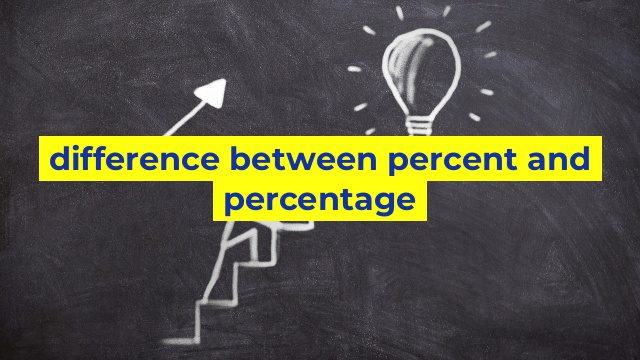Understanding the Difference Between Percent and Percentage: A Comprehensive Guide
Introduction
When it comes to numerical values, it’s important to get the technicalities right. One such confusion arises between the use of “percent” and “percentage.” Although they are often used interchangeably, they have different uses and contexts. Understanding the differences between the two can help you use them accurately in your writing or documents.
Percent vs. Percentage: What’s the Difference?
The fundamental difference between percent and percentage is that percent refers to a specific fraction of 100, while percentage is the term used to describe the relationship between two values. In simpler words, percent refers to a value in relation to 100, whereas percentage indicates a group or a portion of a whole.
Another way to look at it is that percent is an adjective, while percentage is a noun. Percent is used to describe something, such as “a 20 percent increase,” while percentage is used to refer to a specific value, such as “the percentage of people who liked the product.”
Examples of Correct Usage
Here are a few examples that illustrate the correct use of percent and percentage:
1. “The company witnessed a 50 percent increase in sales this year.” (Here, percent is used as an adjective to describe the extent of the increase, i.e., out of 100.)
2. “The percentage of Americans who own a smartphone is increasing every year.” (Here, percentage refers to the specific value, i.e., the ratio of people who own a smartphone.)
3. “The teacher allowed a 30 percent late submission of assignments.” (Here, percent refers to the fraction of time allowed for late submission.)
The Importance of Proper Usage
Using percent and percentage accurately matters, especially in the world of business and finance. Misusing these terms can have serious implications and affect the accuracy of data analysis. Additionally, using the wrong term can lead to confusion and misinterpretation of your message, both in written and spoken communication.
Conclusion
In conclusion, percent and percentage are two similar terms with different uses and contexts. Percent refers to a specific fraction of 100, while percentage is a term used to describe the relationship between two values. It’s important to use these terms accurately to avoid any confusion and ensure clear communication.
Table difference between percent and percentage
| Percent | Percentage |
|---|---|
| A fraction of 100. | A portion or share of a whole. |
| 100% equals 1 whole. | The value expressed as a percentage of the whole. |
| Example: 50% of 200 is 100. | Example: Sales tax is calculated as a percentage of the total purchase price. |
